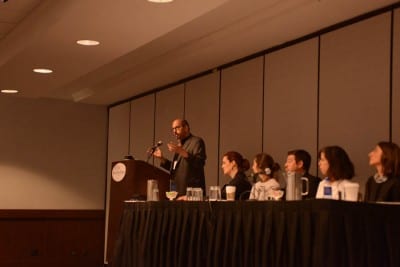
Photo of panelists at the Society of Contemporary Art Historian’s panel, Histories and Economies of Contemporary Art, which was held at the College Art Association 103rd Annual Conference in New York, on February 11, 2015 (photograph by Bradley Marks)
Once upon a time, not even a decade ago, I was among an initial wave of young scholars who had written a dissertation on a living artist and were forging a career in a nascent subfield of the discipline: contemporary art history. As part of a generation permitted—as a function of ideology and bureaucracy—to do such work within the context of an established graduate program, and to emerge from that pedagogical possibility into a world where jobs for the study of recent art and its institutions had come to exist, I witnessed the turning of this temporal category into something more epistemic. Despite the rapidly swelling numbers of new courses, articles, and books, little support existed for these scholarly engagements. For many—whether historians of the deeper past; humanists in related fields; or social, life, or applied scientists—contemporary art history seemed not scholarly enough: too presentist, too creative, too indissoluble from criticism and hence not credibly objective. Not eligible for peer review since it by definition constitutes a form of refereeing, criticism—as something related to (and even necessary for) but ultimately distinct from the work of contemporary art history—posed problems for tenure review, to cite an example of the complications wrought thereupon.
Instead of appealing to a position of exceptionalism for the contemporary, I started to think that we needed more connection to those studying other periods, not less. It was with these considerations in mind that I founded the Society of Contemporary Art Historians with Alexander Dumbadze and Joshua Shannon. For visibility and advocacy, it was critical to engage with the College Art Association as a way to help graduate students and junior faculty regarding the language and implications of their work in this area and to offer a platform to make more public the conversations that were already happening elsewhere on smaller scales. We became a CAA affiliate in 2007, with the mandate (according to bylines we drafted) to “promote collegiality and foster community within the vital field of contemporary art history. The Society seeks to promote knowledge of contemporary art history and visual culture through facilitation of discussion groups, presentations of works in progress, and the active encouragement of research among its members. It further proposes to encourage mentoring and facilitating career development through its active listserv and annual meetings at the College Art Association annual conference.”
In some ways, the success of SCAH—but more so, the becoming contemporary of art history—has been pyrrhic. Although it sounds patently absurd from the perspective of where I began, the assimilation has been total, and many students matriculating into programs have little understanding of how far from inevitable were the instantiation of our current conditions. Instead of perpetuating a stance of precarity, we must acknowledge our having become so thoroughly official (to be clear, precarity is all too real in current conditions of higher education, but this is far from specific to our field). And we must ask now, as before, though with a different motivation and inflection: whither the contemporary? For SCAH, now stewarded by John Tain, issues must extend beyond the North American location of the home organization. We must not only take into account and incorporate more fully the global turn at the level of research but also participate in an international art world of which the academy is a constitutive member. In the coming year, too, the Society will be presenting a panel on exhibition and exhibition histories as part of the annual CAA Conference, a reflection of the growing interest in exhibition history as an area of research for both art historians and curators. In addition, the current executive board is developing plans to expand its presence by growing our membership base and proposing additional projects throughout the year.
All of this is to say that to be contemporary is necessarily to be of one’s time, and times change. This recognition is patent in our research questions, methods, and publication venues. But just because contemporary art history, like the contemporary as such, is a moving target does not obviate responsibility; instead, over and again it mandates such frank accounting anew.
-Suzanne Hudson, on behalf of Society of Contemporary Art Historians
For more information on Society of Contemporary Art Historians, contact scah.info@gmail.com or visit http://scahweb.org.

